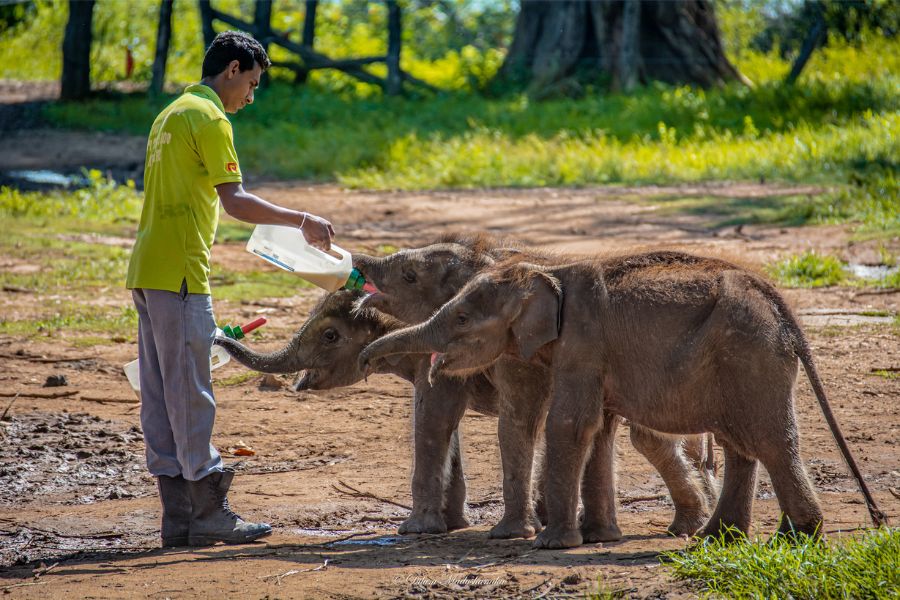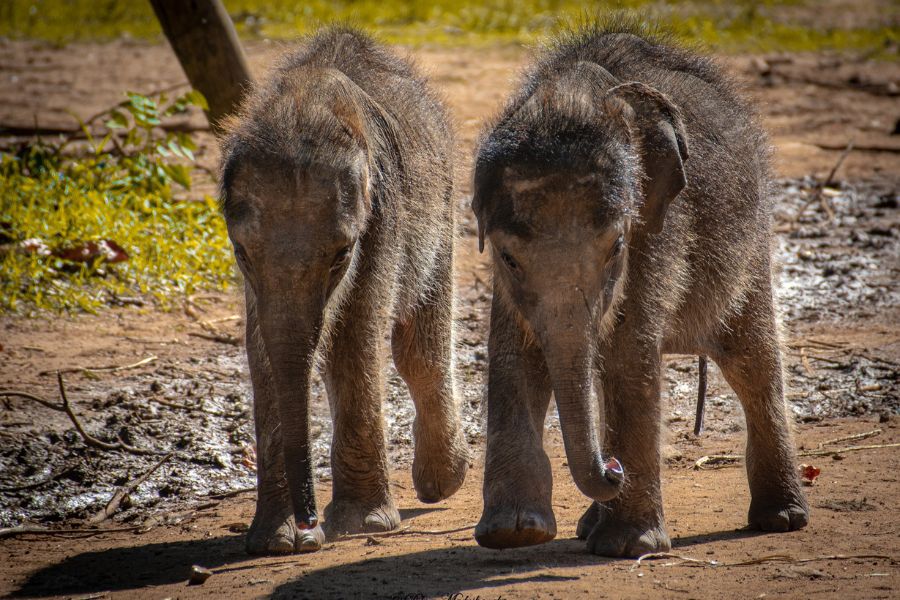Rehabilitation of Wild Elephant Calves in Sri Lanka: A Journey of Conservation and Coexistence
In the heart of Sri Lanka, where the grassy plains of Udawalawe National Park stretch far and wide, the silhouette of a small elephant calf stumbles across the horizon, alone and vulnerable. It is a heartbreaking scene that reflects a much larger crisis—Sri Lanka’s escalating human-elephant conflict (HEC). Orphaned calves, like this one, are the tragic consequence of these ongoing confrontations between humans and one of Sri Lanka’s most revered creatures.
Sri Lanka is home to approximately 6,000 wild elephants, a figure that masks the fragile balance between conservation and survival. As human populations grow and settlements expand, elephants—once symbols of strength, wisdom, and prosperity—are increasingly seen as threats by farmers whose crops and livelihoods are destroyed. As a result, the country faces one of the world’s most severe HEC crises, with both elephants and humans suffering the consequences.

A Ray of Hope: The Elephant Transit Home (ETH)
Located within Udawalawe National Park is the Elephant Transit Home (ETH), a sanctuary established in 1995, dedicated to saving orphaned elephant calves. Here, calves receive medical attention, nourishment, and the crucial socialization needed for their eventual reintroduction to the wild. Since its inception, the ETH has rehabilitated and released over 300 calves, a testament to its role in Sri Lanka’s conservation efforts. But, while ETH offers hope, HEC continues to leave more calves orphaned every year, emphasizing the need for broader, sustainable solutions.
The rehabilitation of elephants at the Elephant Transit Home (ETH) is a meticulously designed process based on scientific principles and models of wildlife conservation. When calves are rescued, they receive immediate medical attention, which includes treatment for injuries and diseases, hydration, and nutritional support tailored to their age and health status. The ETH employs a structured feeding regime using a specialized milk formula developed to mimic the nutrients found in a mother elephant’s milk, ensuring optimal growth and development.
The rehabilitation process emphasizes minimal human contact to help maintain the calves’ wild instincts, allowing them to adapt to their natural behaviours. The elephants are gradually introduced to a social structure that mirrors wild herds, fostering essential social interactions.
The rehabilitation timeline is closely monitored, and the calves are only released when they exhibit the necessary skills to survive independently, which typically occurs between three to four years of age. This model not only emphasizes the welfare of the elephants but also aims to ensure their successful reintegration into their natural habitat, highlighting the balance between conservation efforts and the natural behaviours of these majestic animals.
Coexistence at Ahaspokuna: A Unique Eco-Tourism Model
Enter Ahaspokuna Bush Walk Camp, an innovative model of eco-tourism that provides guests with an immersive wilderness experience while promoting a harmonious coexistence between humans and elephants. Unlike traditional safari camps, Ahaspokuna places an emphasis on non-intrusive tourism. Guests are fenced within the camp for their safety, but elephants roam freely along their ancient migratory paths, undisturbed by human presence.
This model represents a powerful shift in how wildlife tourism can contribute to conservation and coexistence. Instead of forcing animals to adapt to human spaces, Ahaspokuna adapts human spaces and activities to fit the needs of the elephants, allowing the two species to share the land with minimal conflict. The camp also supports conservation initiatives that mitigate HEC, transforming the relationship between local communities and the elephants they once feared.

The Struggle of Human-Elephant Conflict
HEC is more than just a local issue; it is a national crisis. Each year, 100-150 elephants are killed, and nearly 50 people lose their lives in these confrontations. As elephants traverse their ancient migratory routes, now disrupted by human settlements, they inadvertently cause extensive damage to crops and property. Retaliation often takes the form of traps, shootings, and other fatal measures, leaving behind calves who are unable to survive on their own.
While ETH provides a lifeline for these orphans, the solution to HEC must extend beyond rehabilitation centers. This is where eco-tourism plays a critical role in bridging the gap between human livelihoods and wildlife conservation.
Elephants in Sri Lankan Culture: A Sacred Paradox
Elephants have long held a revered position in Sri Lankan culture, particularly in Buddhist traditions where they symbolize power, wisdom, and sanctity. The annual Esala Perahera in Kandy showcases this cultural reverence - though controversial -, where elephants are paraded through the streets adorned in ceremonial garb. Yet, this sacred image stands in stark contrast to the reality faced by rural communities, where elephants are seen as destructive forces threatening livelihoods.
At Ahaspokuna, guests are given a deeper understanding of this cultural paradox. Through guided bushwalks - which replace traditional jeep safaris -, they learn how elephants, once considered both sacred and dangerous, can instead be viewed as integral parts of the ecosystem. The camp’s naturalists emphasize how coexistence can bring economic benefits to communities through eco-tourism, transforming elephants from “pests” into protectors of biodiversity.
A Future of Conservation Through Eco-Tourism
The solution to Sri Lanka’s elephant crisis lies in models like Ahaspokuna and the work done by ETH, where both conservation and eco-tourism come together to create a sustainable future. By visiting Ahaspokuna Bush Walk Camp, guests not only witness the beauty of elephants roaming freely but also contribute directly to their protection. The revenue generated from eco-tourism helps fund local conservation efforts, including HEC mitigation strategies and education programs for nearby communities.
Ahaspokuna offers an opportunity to be part of this journey—a journey that supports the delicate balance of nature and ensures a future where humans and elephants can thrive side by side.
For a firsthand experience of Sri Lanka’s elephants, consider booking your stay at Ahaspokuna Bush Walk Camp. By doing so, you’ll be contributing to the long-term preservation of these magnificent creatures, ensuring that future generations can witness elephants in the wild.

References:
- Elephant Transit Home, Sri Lanka - Department of Wildlife Conservation
- Sri Lanka’s Elephant Crisis: Human-Elephant Conflict - World Wildlife Fund
- Human-Elephant Conflict: Causes and Mitigation Strategies - ResearchGate
- Ahaspokuna Bush Walk Camp - Ahaspokuna

